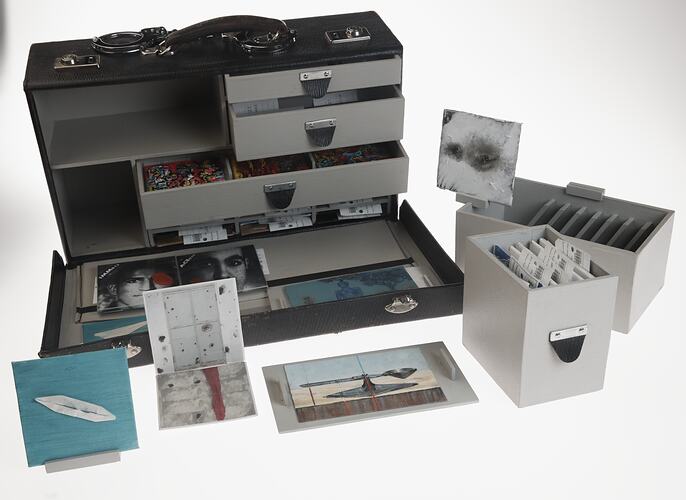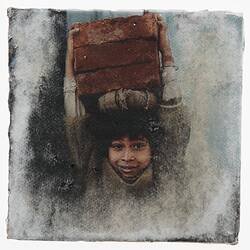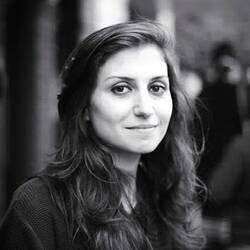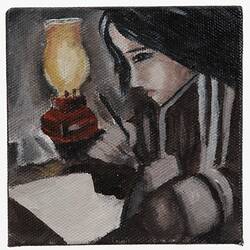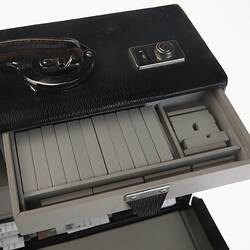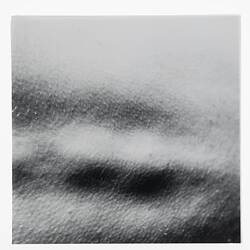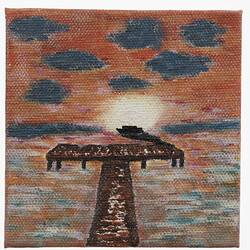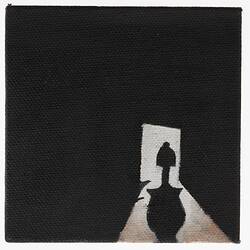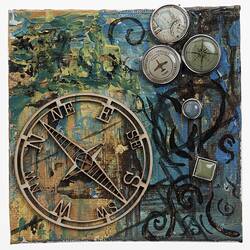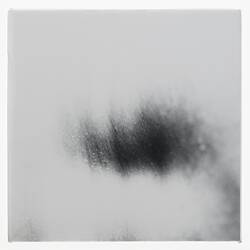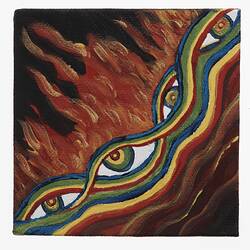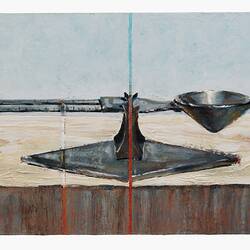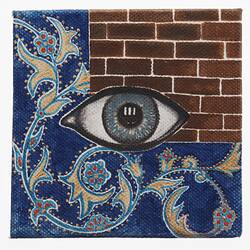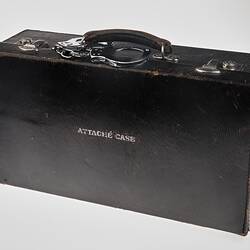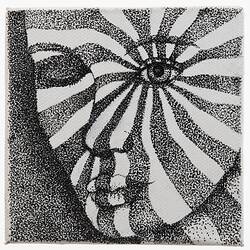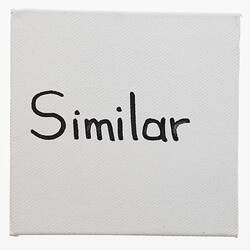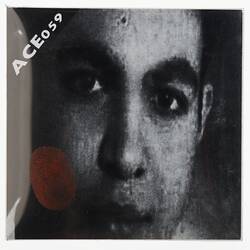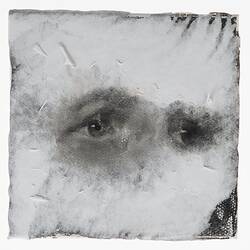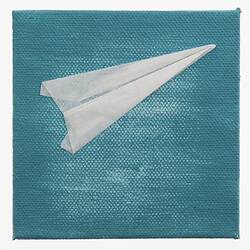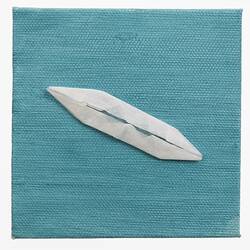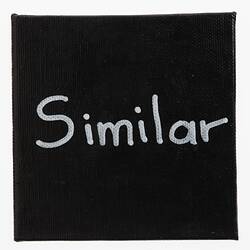Summary
The Museum's 'Attache Case' artwork provides a platform for contemporary refugee and asylum seeker's voices, concerns, and personal perspectives; and tells us much about the migration journey and their thoughts and feelings about building a new life in Australia.
Introduction:
'Attache Case' is an artwork comprised of a re-purposed doctor's medical case which opens to reveal small drawers containing 41 miniature paintings representing 21 artists of refugee background from Afghanistan, Vietnam, Poland, Hungary, Colombia, Sri Lanka, Iran, Egypt and Iraq. The piece was created by Melbourne-based curator, writer, artist and lecturer Peter Burke in 2015 as part of an international touring art installation 'Low Cost Diplomatic Bag' auspiced by the Spanish Embassy. 'Attache Case' was acquired by Museums Victoria in 2019 (HT 56009).
Alyana Eau, a contributing artist ('Waiting 1991 Gulf War - Zakho, Iraq' HT 56009.2) who fled Iraq in 1998, stated in 2021 that: 'Through art, I can convey what words cannot portray and I express myself without boundaries or limitations. Art to me is more influential and powerful than any language, it is freedom of thought, and it is what my emotions speak.'
Alyana conveys that art is a powerful way to convey experiences that are emotionally complicated, beyond words and borders. As historical artefacts in conversation with one another, the contemporary refugee and asylum seeker's voices, concerns, and personal perspectives revealed through the 'Attache Case' artwork tell us much about the migration journey and their thoughts and feelings about building a new life in Australia.
The Journey:
The migration journey is central to the purpose and meaning of the lives of refugees and asylum seekers. 'Attache Case' artist, Dagmara Gieysztor' states, 'People always ask how you got to Australia, instead of why did you have to leave your country.' She conveys this in her two works entitled, 'How? Not Why.' (HT56009.11 and HT56009.12). There are so many reasons amongst this group of asylum seekers and artists for why they had to leave their countries, including war and the need for escape from persecution. Mehdi Jaghuri, a Hazara refugee from the age of 12, painted the injustices of child labour (HT56009.21, HT 56009.23) and the symbolic restrictions of the 'Burka' (HT56009.22) that drove he and his family to leave Afghanistan. Neda Daryabar's painting 'I cherish, appreciate, celebrate' (HT56009.27) expresses her past memories, which form part of who she is today. Other artists, such as BHR, reveal that the journey is filled with uncertainty for 'who knows what's behind unknown waters.' and living in 'Limbo' thereafter (HT56009.9, HT56009.10).
The journey to resettle in Australia includes a significant amount of time waiting in detention, as illuminated in Mitra Ashtiani's 'Limbo' and 'Expectation' (HT 56009.37, HT56009.38). Waiting is a recurring theme that reflects on the experiences of protracted processing for entry, gaining refugee status, and permanent resident status once allowed onto Australian soil. Samaneh Malekshahi's paintings (HT56009.29, HT 56009.30) depict waiting in detention as an endless state of being. Sriharan Ganeshan's painting, 'Child in Camp' (HT56009.36) and mixed media work openly critique detention. Rayka Kouchaksaraei's artwork features photographs of two asylum seekers, Hamid Khazaei and Reza Barati, who died in detention (HT 56009.37, HT56009.38). Rayka's works seeks to counter what Gyorgyi Marek depicts in 'No eye, no mouth, no will' ( HT 56009.13) as the facelessness and dehumanisation asylum seekers experience in detention, as well as the sense of disconnection and reliance on the mercy of others (HT 56009.14, HT56009.15).
Waiting in detention for refugee status or permanent residency on mainland Australia brings up a variety of emotions. Eghbal, a 'self-taught artist' who started learning art practice in the detention centre, expresses the injustice, disappointment, and despair of waiting for refugee status and the desire 'to study, that's all I wanted. It's about 6 years, I'm waiting' (HT56009.34, HT56009.35). To endure detention, Carmenza Jimenez painted colourful murals on the walls inside the detention centre and continued to do art in resettlement to provoke viewers' empathy about 'Similar' experiences (HT56009.7, HT56009.8).
Asylum Seekers' Thoughts and Feelings:
The artists and contributors to 'Attache Case' convey a range of thoughts and feelings about freedom, opportunities, life in Australia, resettlement, optimism, despair, grief, hope, fear and anger, and the consequences of living in limbo. Anthony Rodriguez' two paintings 'Amorscapes' attempts to move 'beyond trauma: pain, sorrow' (HT 56009.3, HT56009.4); Noony's work 'The Song of Silence' grapples with death (HT 56009.28), whilst Minh Phan's 'Still Life (On Balance)' is, as he writes, a 'reflection and proposition on the principle of balanced asymmetry' (HT56009.26).
Resettlement allows, even requires, time for reflection and creative contemplation through the production of art about home, belonging, and what asylum seekers have experienced and witnessed. Zohreh Izadikia expresses in her paintings, 'Dichotomy' (HT 56009.31), 'Broken' (HT 56009.32), and 'Hesitance' (HT 56009.33) the conflicts of coping with everyday life in resettlement.
Most of the artists and contributors to 'Attache Case' 'explored art as a form of escape and finding beauty even in terrible and distressing circumstances,' which is the purpose and mission of what Dr Margaret Mayhew envisaged when she 'worked with some Iranian refugees in the MITA detention centre to paint images of flowers' (HTS56009.42). Maryam Sepasi, one of the Iranian detainees that learned from Margaret, continued to paint and draw in resettlement to date (HT56009.17, HT56009.18, HT56009.19, HT56009.20). Art in its ability to express refugee and asylum seekers thoughts and feelings is also an expression of belonging, a desire a central to the experience as migrants in Australia.
Art also provokes questions to it viewers as Tadros Hanna asks in his works: 'My journey is a journey from pain to hope, what about yours?' (HT56009.39, HT56009.40, HT56009.41). 'Attache Case' in this way seeks to inspire us to reflect on our own thoughts and feelings about migration.
More Information
-
Keywords
-
Authors
-
Article types
